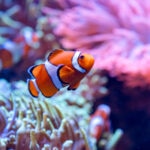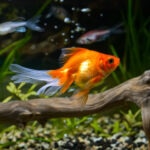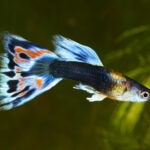How To Spot Signs Of Distress In Your Fish Before It’s Too Late

Photo by Chewy
You are running late for work, there is a long line at your local coffee shop and your engine light just turned on. Sometimes, we just have stressful days. In humans, it is fairly easy to determine when someone is stressed. In many cases, just asking someone about their day will provide you all you need to know. In other cases, facial expressions are often sufficient to let us know somebody is having a bad day. But what about our fish? How can you measure distress in them?
They don’t grimace or raise their eyelids (because they don’t have eyelids to raise). They don’t usually vocalize. Therefore, we need to look at behavior to determine whether our fish are stressed. We need to work at developing regular routines in caring for our fish and the aquarium(s) so that the likelihood of new problems arising, and the accompanying stress, are minimized.
Watch for Distress
Fish have evolved to mask their illness. They are masters at looking normal and healthy, even with severe disease issues. This evolutionary trait is a protective mechanism that limits the likelihood that a predator will spot them in a school of fish and attempt to catch them for an easy meal. Of course, this makes our jobs more difficult as aquarists.
If we are only spending a small amount of time with our fish, we may not develop the observation skills we need to know their normal routines. This is one of those cases where you get to make the excuse not to mow the lawn or pick up the kids toys. You need to spend time watching your fish to help prevent the likelihood of problems. For me, it is a perfect excuse to enjoy a cup of coffee and relax in front of my aquariums. When you spend time watching your fish, you will note that they have specific physiologic functions or behaviors that change when they are distressed. The functions and behaviors that I like to monitor are:
- Appetite. Do the fish show interest in food when it is presented?
- Mentation. Do the fish seem alert and aware of their surroundings?
- Respiration. What is the fish’s breathing rate? Is it fast (tachypnea) or slow (bradypnea)?
- Swimming activity. Are the fish actively swimming?
- Color. Are the fish their “normal” color?
Appetite Issues
Appetite is an important behavior to monitor. Fish have relatively few functions in life. Eat. Grow. Eat some more. Reproduce. Pretty simple. Growth and reproduction are dependent on the fish having sufficient energy available; any change in appetite or eating is an indication that something is wrong.
Skin and gill flukes can cause significant disease in fish. In many cases, these parasites are at low burdens, but their numbers increase when fish become stressed. This becomes a real problem for fish that are sick. If they stop eating, they won’t obtain the energy required to heal. However, it is important to not confuse a lack of appetite from stress with the provision of the wrong diet.
Fish have evolved to feed on different types of diets. They can be herbivores, omnivores or carnivores. If fish are not offered the correct type of diet, they won’t eat. It may not be uncommon to see some fish mouth their food and then spit it out. Of course, feeding the wrong diet itself can be stressful to the fish and needs to be remedied. So, why is a decreased appetite a sign of distress? Stress can induce a flight or fight response. If you are a neon tetra, your fight response is not very high; instead, you tend to flee. If you are under duress and constantly in flight mode, then you will spend more time watching out for what might attack you than looking around for your next meal. Eventually, this catches up with the fish. The lack of food intake (energy) leads the body to catabolize its energy stores (e.g., liver, muscle and fat), which can lead to weakness and decreased swimming activity. The lack of new digestible energy (food) also leads to a reduction of the energy available for other important functions, such as immune function. Ultimately, this may make the fish more susceptible to infections.
Awareness
Mentation, or the awareness of a fish, can only be determined by knowing something about the fish’s life history. It is important to know if a fish is an active swimmer that is constantly looking around its environment for food or mates (e.g., guppies and mollies), or if it is a benthic fish that normally lies on the bottom of the aquarium. Some fish may appear quite lazy and dull (e.g., catfish); however, this can be misleading, as these animals may be nocturnal and only active at night. In addition, some fish can actually take on a “restful” appearance.
Clown loaches are commonly found lying on the substrate or oscar fish laying on their side, as if taking a nap. If you stimulate them, they will perk right up. These may represent examples where some form of environmental enrichment, such as hiding the fish’s food and making it spend time searching for it, will increase their activity and decreases their “nap time.” However, if the fish’s mentation is truly dulled (depressed and lying on bottom when it should be an active swimmer) or over stimulated (swimming as if agitated and racing into the sides of the aquarium), then there can be a real disease issue (e.g., infectious disease, toxin in water—ammonia) and the animal may truly be in distress. Following up with a veterinarian to determine the underlying cause for the change in mentation is needed so that it can be corrected.
Aquarium Fish Respiration
A fish’s respirations rate, much like our own, can tell us something about its stress level. When humans or animals are stressed, respiration rates increase. This is in preparation for a fight or flight response. By increasing our respirations, we increase the oxygen concentrations available to our tissues.
The best way to measure breathing for most fish is to count the number of times their operculae (gill covers) move. If you are looking at sharks or stingrays, measure spiracle and gill slit movement. Boney fish (or teleosts) are the most common type of freshwater and marine fish in aquariums and ponds. These fish have four gills in each gill chamber. Sharks and stingrays have five to seven gills on each side. The respiratory system of fish is very efficient. Blood flows through the gills in the opposite direction that water is moving past the gills, which maximizes the off-loading of toxins and uploading oxygen. Any change to this system can decrease its efficiency and lead to problems for the fish.
Poor water quality and infectious diseases (bacterial, fungal, parasitic, and viral) are common stressors that can affect a fish’s respiration rate. These problems stimulate the gills to secrete mucus as a protective measure; however, this mucus covers the gills and limits the direct water-gill contact necessary for gas exchange and off-loading toxins (e.g., ammonia). When there is increased mucus production, the fish increase their respiration rate to off-set this reduced efficiency. It is good practice to know the normal respiration rate of your fish, so that when things are abnormal, you will be able to spot it. Respiration rates of fish can vary widely (20 to 80 opercular movements per minute) under normal conditions.
Swimming Activity
Swimming activity can tell us a great deal about how a fish is feeling. Fish have evolved with a specific anatomy to allow them to make their way through the water, and there is a huge diversity among the 25,000-plus species of fish in the world. For example, the modifications of the pectoral fins of stingrays or anal fins of knifefish allow them to undulate gracefully through the water. A stingray buried in the substrate or a knifefish sitting motionless in a log are not abnormal; however, if you stimulate them to move and they don’t, then a problem may exist.
The stress and injuries fish experience will leave them vulnerable to disease. When assessing swimming activity, first determine if the activity is increased or decreased. Darting through the water and frantically swimming are indicators that the fish are under duress and that the problem is acute (recent). In many cases, these activities are associated with other fish in the aquarium and may include conspecifics (the same species) or water quality issues. Elevated ammonia, nitrite or chlorine concentrations can be irritating to the fish and cause them to try to swim away from the problem. Unfortunately, in a closed system like an aquarium, there is nowhere for the fish to escape. When swimming activity is decreased, it typically indicates a chronic problem. These fish tend to be those mentioned previously that also have a decreased appetite and mentation, and their swimming activity is decreased because they are weak.
Color
When a fish is under duress, its colors, which are influenced by the endocrine system, can fade. The endocrine system is responsible for hormone production, including the stress hormone corticosterone. Corticosteron can lead to fading, and this fading is often one of the first signs of fish distress. Maintaining beautiful colors requires energy, and when in distress, fish are not taking in energy (food) or they are directing it toward more vital functions (e.g., fight or flight response).
Minimizing Stress in Aquarium Fish
It is important to recognize that it is impossible to eliminate stress completely. Complex systems, like an aquarium, are always changing, and these changes create new challenges for the individuals living in the system. But this can be a good thing.
Stress provides vertebrates, like fish, challenges to their behavior and physiology that make them more adaptable. For example, while the diet of African cichlids in the wild may include plant materials, zooplankton or other fish, many of these fish readily adapt to flake foods or pellets, which look nothing like their native foods and may initially be a stress until they figure out that this food provides the energy they need.
The problem with stress is when it becomes chronic, excessive and inescapable. As noted earlier, fish that are provided an inappropriate diet, are constantly under duress from the aggression of a conspecific or other tank mate, or are housed under less-than-ideal water parameters, will not find that the stress makes them more adaptable; instead, it may kill them.
Fish are the only group of pet animals that live and breathe in the same place that they eat and use the bathroom. Because of this, it is possible for toxins (e.g., ammonia, nitrite) to build in the water and cause health issues. When fish are presented to me at my veterinary practice, water-quality issues tend to be a primary, secondary or tertiary issue.
Novice aquarists or pondkeepers might not fully understand the inorganic chemistry involved with maintaining good water quality. In these cases, water-quality issues can be primary stressors to the fish. High ammonia can lead to increased mucus production on the gills and body. Affected fish will become tachypneic (breathe faster) as a result of the reduced potential for gas exchange at the gills. Affected fish will also produce increased mucus on the body as a result of the irritation of the ammonia. Fish may rub against surfaces within the aquarium because of the irritation (burning) caused by the ammonia. These cases are easy to identify. When water serves as a secondary or tertiary issue, it can be more difficult to determine exactly how fish are affected by the water. The pH fluctuations that are mild may cause these types of stresses. Having a low alkalinity (low buffering capacity) may allow for minor fluctuations in pH throughout the day based on other parameters (e.g., amount of light, phytoplankton numbers, oxygen and carbon dioxide concentrations). Because pH is based on a logarithmic scale (based on orders of magnitude where differences between two numbers are multiplied by a value), these small changes are actually larger than they appear.
Regardless of whether these water problems are a primary or secondary issue, they can represent an unnecessary stress to the fish. It is important for aquarists to test their water regularly. Under certain conditions, such as a new system, this may be daily, depending on stocking densities, while for established systems it may be weekly, bi-weekly or monthly. When aquarists create their aquatic communities, they often do so by selecting fish that excite them because of their aesthetics (e.g., angelfish or discus) or a particular behavior (e.g., monster fish that behave like dogs); however, these communities may not always be best for the fish.
Many aquariums look like international airports—a mix of individuals from different continents sharing a small space. Tankmates can be a source of chronic stress, as some fish must compete to share similar space and food within the aquarium. In fact, conspecifics (same species), in particular, can provide stress to their tankmates.
Some fish are natural bullies, and this can cause others living in their environment to develop health issues from the stress. The best way to avoid these types of stressors is to create aquarium populations that are balanced. Select species that will mix without heavy competition. I like to select fish that will occupy the aquarium from top to bottom, including the upper, middle and bottom levels of the aquarium (on the substrate).
By selecting fish that will fill each of these niches, you can “fill” the tank, as well as reduce competition between fish. When considering numbers of fish to purchase, it is important to select them based on whether they naturally school or not. A common mistake is to obtain multiple animals from a species that is not a schooling fish. This leads to competition between the different animals to share space, and in some cases, certain fish species just don’t like their brethren (e.g., Betta splendens). Taking time to plan which species will work together will go a long way in creating harmony within the aquarium and peace for the aquarist.
Plan Ahead for a Healthy Aquarium
The best way to ensure that you can have a healthy fish aquarium is to plan ahead and spend time working with and enjoying your fish. Developing routines that ensure you regularly monitor your fish and aquarium water quality will help you to identify small changes in behavior or water quality before they become big problems. After all, the purpose of having an aquarium is to enjoy the fish and reduce your stress on those days when things don’t go your way.
Mark A. Mitchell, DVM,MS, PhD, DECZM (Herpetology) is a professor of zoological medicine at the University of Illinois. He has been an aquarist for 30 years and still finds great joy in keeping and breeding aquarium fish.



